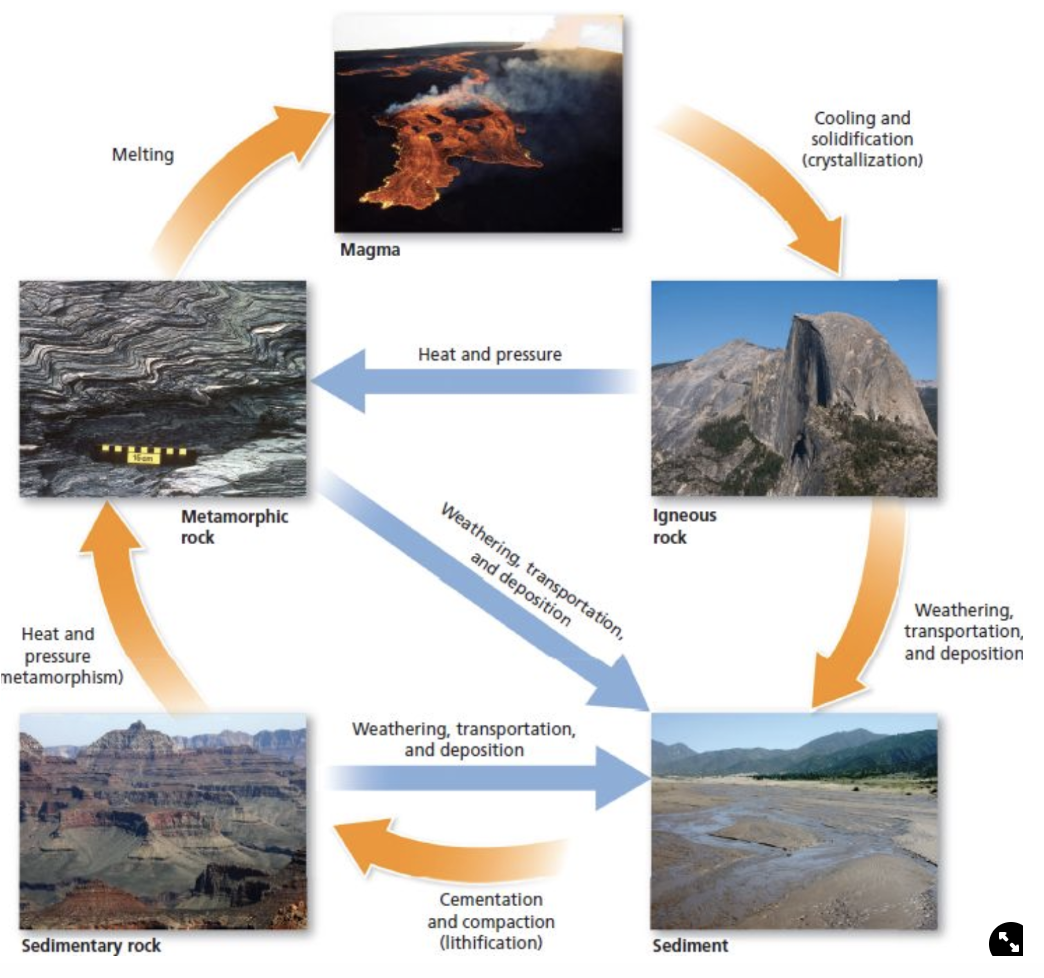Lecture 5: Minerals and Rocks
Minerals
Minerals A naturally occurring, inorganic solid with a specific chemical composition and a crystalline structure.
Naturally occurring solids
Definable chemical composition
Crystalline structure (ordered internal structure at atomic scale)
Typically inorganic
Formed by geological processes
Freezing from a melt
Precipitation from solution
Chemical reaction
Physical Properties
Physical properties include color, streak, luster, specific gravity, crystal habit, cleavage, and fracture.
Mohs Hardness Scale: a scale from 1 to 10 that measures the hardness of minerals based on their ability to scratch or be scratched by other substances.
Dominate Elements
Element abundances in Earth’s crust depends on percentage by weight.
Oxygen (O) and Silica (S) are the most abundant.
Make up the silicates (most abundant minerals in crust)
Silicates
The dominate class
Minerals that contain silicon and oxygen, typically combined with other elements like aluminum, iron, magnesium, or potassium. They are the most common group of minerals in Earth's crust, including minerals like quartz, feldspar, and mica.
Non-Silicates
Oxides, Sulfides, Sulfates, Phosphates, Carbonates, and Halides.
Igneous Rocks
Igneous rocks: forms from the cooling and solidification of molten a melt (magma or lava).
Magma: melt below Earth’s surface.
Lava: melt above Earth’s surface.
Causes of Melt
Decompression: The reduction of pressure or stress on magma, allowing it to rise and potentially solidify as it moves towards the Earth's surface.
Addition of volatiles: gases like water vapor, carbon dioxide, sulfur dioxide, and methane found in magma.
Heat transfer from rising magma.
Why Does Magma Rise?
Less dense than surrounding rock.
Can be squeezed up by weight of overlying rock.
Rate magma rises depends to its viscosity (resistance to flow).
Viscosity is resistance to flow.
Depends on temperature, volatile content and silica content.
Magnetic Differentiation
Process by which different rocks form from a single magma
Partial melting
Assimilation
Fractional crystallization
Primary Classes of Igneous Rocks
Volcanic rocks (extrusive) - no crystals
Plutonic rocks (intrusive) - has crystals
Both have different composition and texture
Composition: refers to the types and proportions of minerals and other materials that make up the rock. It determines the rock's physical and chemical properties.
Texture: size of crystals in rock
Bowen’s Reaction Series
Shows and explains as magma cools, how the mineralogy begins to form.
Describes the sequence of mineral crystallization from cooling magma.
Shows how minerals crystallize in a predictable order as magma cools, with a continuous series of mineral formation in response to temperature changes, and a discontinuous series where minerals form in distinct stages.
Textures
Aphanitic: Small, fine grained crystals due to fast cooling.
Examples: rhyolite, andesite, basalt
Phaneritic: Visible crystals, cools slowly, intrusive
Examples: granite, gabbro
Other textures: glassy, porphyritic, vesicular (gas bubbles), frothy (small pores), pegmatitic
Sedimentary Rocks
Sedimentary rocks: formed from the accumulation, compaction, and cementation of sediments, which can include fragments of other rocks, minerals, and organic materials.
Provides more information about Earth’s history than other rock types.
Cover lots of land
Create loose sediment
Lithification: sediments compressed and/or cemented to form solid rock.
Form horizontal layers (strata)
Weathering: decomposition of rocks through physical, chemical, and biological processes.
Erosion and transportation: bring weathering products into depositional environments.
Classifying Sedimentary Rocks
Classified by composition and texture
Clastic: composed of mineral grains weathered from pre-existing rock and cemented together by precipitated minerals.
Carbonate: chemically or biologically precipitated, marine.
Other: chert, evaporates, coal
Clastic
Gravel → Sand → Silt → Clay
Carbonate Examples
Limestone, Chalk, Tufa
Metamorphic Rocks
Metamorphic rocks: Formed from the alteration of existing rocks (igneous, sedimentary, or other metamorphic rocks) through heat, pressure, and chemical processes, resulting in new mineralogical and structural features.
Change in texture and mineralogy
Protolith or parent rock is the original rock before transformation.
Solid-state change: the transformation of a rock's mineral composition and structure without melting, through processes like heat and pressure, which leads to the formation of new minerals and textures.
Slow process
Composition and Texture
Primary criteria for classifying metamorphic rocks.
Metamorphic grade: change in texture and mineral
Low grade: can’t see minerals
Intermediate grade: can see minerals
High grade: banded minerals
Foliation and Differential Stress
Foliation: a planar alignment of metamorphic minerals (especially micas) with mineral alignment perpendicular to highest stress direction; differential pressure (or stress) is applied.
Examples: shale, slate, phyllite, schist, gneiss
Non-foliated: metamorphic rocks that lack a layered or banded appearance, with minerals that are recrystallized without a preferred orientation; uniform pressure (or stress) is applied.
Examples: marble, anthracite, quartzite
The Rock Cycle
Sedimentary rocks are from weathered sediments of preexisting rocks
Metamorphic rocks are preexisting rocks that have changed through temperature and pressure increases.
Igneous rocks are made from rocks that have melted and recrystallized.
Rock and Plate Tectonics
Plate tectonics are driving force for the rock cycle.
Conversion plate boundaries
